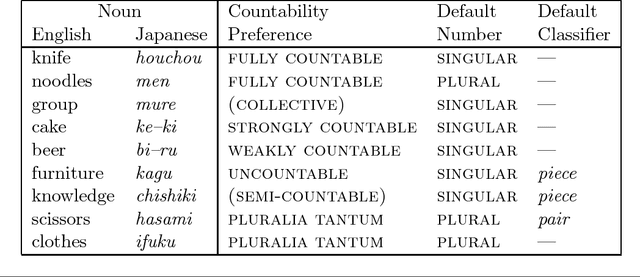Satoru Ikehara
Tottori University
Classifiers in Japanese-to-English Machine Translation
Aug 21, 1996
Abstract:This paper proposes an analysis of classifiers into four major types: UNIT, METRIC, GROUP and SPECIES, based on properties of both Japanese and English. The analysis makes possible a uniform and straightforward treatment of noun phrases headed by classifiers in Japanese-to-English machine translation, and has been implemented in the MT system ALT-J/E. Although the analysis is based on the characteristics of, and differences between, Japanese and English, it is shown to be also applicable to the unrelated language Thai.
* 6 pages, LaTeX, uses gb4e.sty, fullname.bst
Possessive Pronouns as Determiners in Japanese-to-English Machine Translation
Jan 23, 1996


Abstract:Possessive pronouns are used as determiners in English when no equivalent would be used in a Japanese sentence with the same meaning. This paper proposes a heuristic method of generating such possessive pronouns even when there is no equivalent in the Japanese. The method uses information about the use of possessive pronouns in English treated as a lexical property of nouns, in addition to contextual information about noun phrase referentiality and the subject and main verb of the sentence that the noun phrase appears in. The proposed method has been implemented in NTT Communication Science Laboratories' Japanese-to-English machine translation system ALT-J/E. In a test set of 6,200 sentences, the proposed method increased the number of noun phrases with appropriate possessive pronouns generated, by 263 to 609, at the cost of generating 83 noun phrases with inappropriate possessive pronouns.
Countability and Number in Japanese-to-English Machine Translation
Nov 03, 1995



Abstract:This paper presents a heuristic method that uses information in the Japanese text along with knowledge of English countability and number stored in transfer dictionaries to determine the countability and number of English noun phrases. Incorporating this method into the machine translation system ALT-J/E, helped to raise the percentage of noun phrases generated with correct use of articles and number from 65% to 73%.
* 7 pages, LaTeX, uses twocolumn.sty, 11pt, lsalike.sty, gb4e.sty
Toward an MT System without Pre-Editing --- Effects of New Methods in ALT-J/E ---
Nov 01, 1995Abstract:Recently, several types of Japanese-to-English machine translation systems have been developed, but all of them require an initial process of rewriting the original text into easily translatable Japanese. Therefore these systems are unsuitable for translating information that needs to be speedily disseminated. To overcome this limitation, a Multi-Level Translation Method based on the Constructive Process Theory has been proposed. This paper describes the benefits of using this method in the Japanese-to-English machine translation system ALT-J/E. In comparison with conventional compositional methods, the Multi-Level Translation Method emphasizes the importance of the meaning contained in expression structures as a whole. It is shown to be capable of translating typical written Japanese based on the meaning of the text in its context, with comparative ease. We are now hopeful of carrying out useful machine translation with no manual pre-editing.
* 9 pages, LaTeX, optional Japanese commented out, uses twocolumn.sty, a4wide.sty, lsalike.sty, gb4e.sty
 Add to Chrome
Add to Chrome Add to Firefox
Add to Firefox Add to Edge
Add to Edge